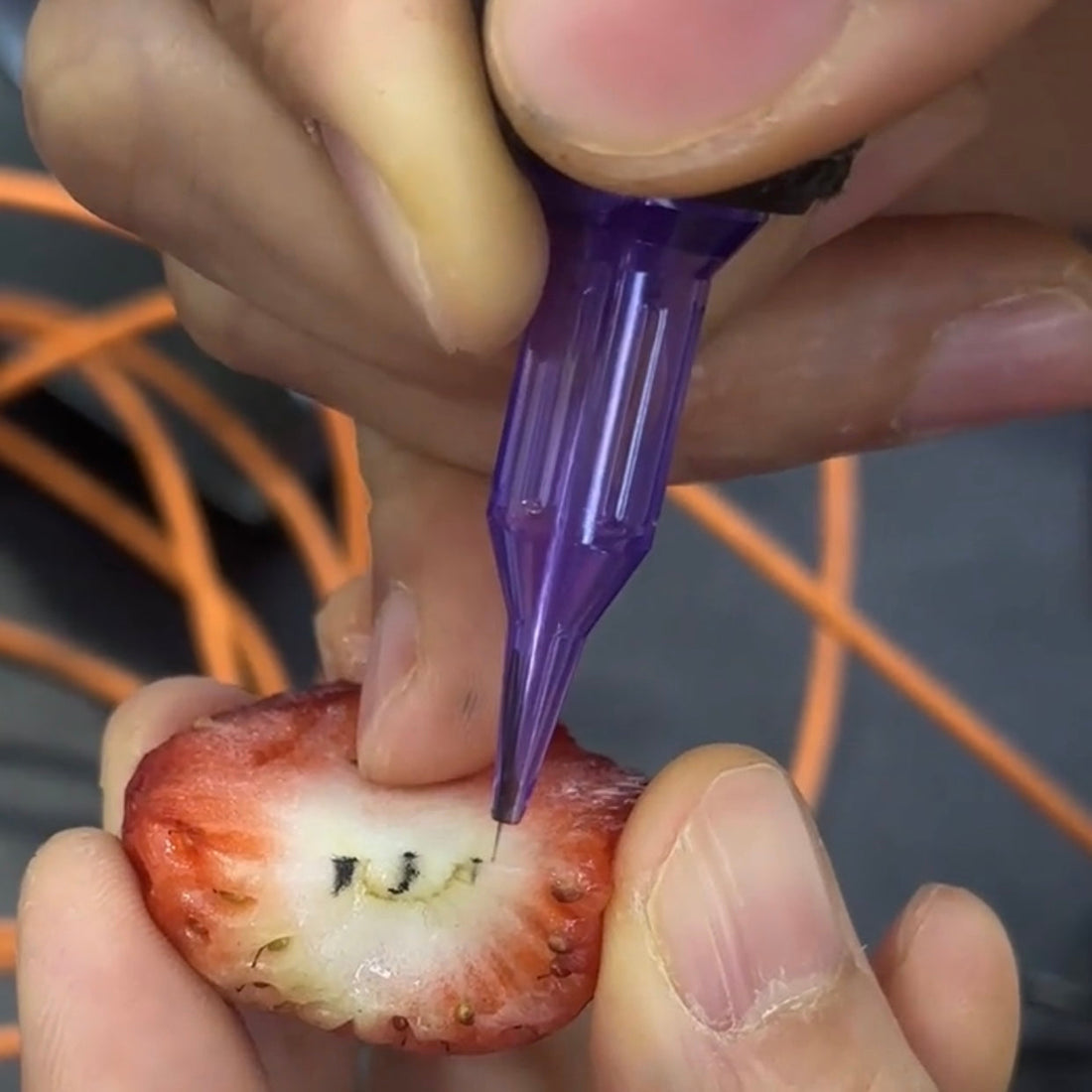 Für maschinelles Augenbrauen-Haarziehen verwenden viele PMU-Artists täglich Strichmaschinen (auch kabellose Rotationsstifte genannt). Allerdings verstehen nicht alle Artists das Konzept der Strichlänge und ihren Einfluss auf die Pigmentimplantation und das Gesamtergebnis vollständig. In diesem Artikel erklären wir die Bedeutung der Strichlänge, ihren Einfluss auf Ihre Arbeit und wie Sie die richtige für Ihre Technik wählen.
Für maschinelles Augenbrauen-Haarziehen verwenden viele PMU-Artists täglich Strichmaschinen (auch kabellose Rotationsstifte genannt). Allerdings verstehen nicht alle Artists das Konzept der Strichlänge und ihren Einfluss auf die Pigmentimplantation und das Gesamtergebnis vollständig. In diesem Artikel erklären wir die Bedeutung der Strichlänge, ihren Einfluss auf Ihre Arbeit und wie Sie die richtige für Ihre Technik wählen.
Was ist die Hublänge bei einer PMU-Maschine?
Vereinfacht ausgedrückt bezeichnet die Hublänge die Distanz, die die Nadel bei jedem Zyklus des Geräts in die Haut hinein und wieder heraus bewegt . Sie ist im Allgemeinen gleich oder größer als die Nadeltiefe und bestimmt, wie tief das Pigment in die Haut eindringen kann. 

Gängige Hublängen auf dem Markt reichen von 2,5 mm, 2,7 mm, 2,9 mm, 3,5 mm bis 4,0 mm . Jede Hublänge über 4,0 mm wird normalerweise als besser geeignet für Tätowiermaschinen denn für PMU angesehen. 
Wie die Strichlänge die Pigmentimplantation beeinflusst
Da die Haut elastisch ist, ist die tatsächliche Tiefe, die die Nadel erreicht, oft etwas geringer als die maximale Hublänge des Geräts. Verschiedene Hauttypen reagieren aufgrund unterschiedlicher Elastizität und Straffheit auch unterschiedlich auf das Eindringen der Nadel.
Wichtige Merkmale der Hublängen:
-
Kürzerer Hub (2,5 mm – 2,9 mm):
- Sorgt für eine sanftere Wirkung auf der Haut.
- Ideal zum Erstellen weicher Haarstriche mit geringer Sättigung .
- Geeignet für Künstler mit einem von Natur aus stärkeren Handdruck.
-
Mittlerer Hub (3,5 mm – 4,0 mm):
- Sorgt für eine stärkere Wirkung und implantiert Pigmente effizienter.
- Am besten für Haarstriche mit höherer Sättigung .
- Empfohlen für Künstler mit leichterem Strich, um eine ordnungsgemäße Pigmentretention zu gewährleisten.
-
Längerer Hub (über 4,0 mm):
- Wird normalerweise eher beim traditionellen Tätowieren als beim PMU verwendet.
- Kann für empfindliche PMU-Arbeiten zu aggressiv sein und zu Übersättigung, Pigmentmigration oder blaugrauen, verheilten Ergebnissen führen.

Warum Sie nicht einfach die längste Hublänge wählen sollten
Manche Künstler gehen davon aus, dass die Verwendung der längsten Strichlänge mit der höchsten Leistungseinstellung zu schnelleren, gesättigteren Strichen führt. Dies mag zwar logisch erscheinen, führt jedoch häufig zu Übersättigung, ungleichmäßiger Pigmentretention und schlechten Heilungsergebnissen .
Stellen Sie sich vor, Sie würden einen Stein aus verschiedenen Höhen fallen lassen:
- Das Fallenlassen eines Steins aus dem 10. Stock (kurze Schlaglänge) hat einen kontrollierten Aufprall.
- Ein Fall aus dem 20. Stock (lange Schlaglänge) erzeugt einen viel stärkeren Aufprall und kann möglicherweise zu Hautverletzungen führen.
Wenn die Hublänge zu lang ist, dringt die Nadel mit zu viel Kraft in die Haut ein . Dies kann dazu führen, dass sich das Pigment zu weit unter der Haut verteilt, was zu Unschärfe und Verfärbungen führt.
So wählen Sie die richtige Strichlänge für Ihren Stil
Ihr Handdruck und Ihre Geschwindigkeit sind Schlüsselfaktoren bei der Bestimmung der für Sie besten Schlaglänge.
- Wenn Sie eine schwere Hand haben, wählen Sie eine kürzere Strichlänge (2,5 mm – 2,9 mm), um eine Übersättigung zu vermeiden.
- Wenn Sie eine sehr leichte Hand haben, kann eine etwas längere Strichlänge (3,5 mm – 4,0 mm) zu einer besseren Pigmentretention beitragen.
- Wenn Sie unsicher sind, beginnen Sie mit einem mittleren Strich (3,0 mm – 3,5 mm) und passen Sie ihn je nach Ergebnis an.

Anpassen von Leistung und Geschwindigkeit für unterschiedliche Hublängen
Je höher die Hublänge, desto niedriger die empfohlene Geschwindigkeitseinstellung .
Allgemeine Richtlinien zu Leistung und Geschwindigkeit:
- 4,0 mm Hub → Niedrigere Geschwindigkeit (1–2 Einstellungen)
- 3,5 mm Hub → Mittlere Geschwindigkeit (3–3,5 Einstellungen)
- 2,5 mm Hub → Höhere Geschwindigkeit (3,5–4 Einstellungen)
Dies sind jedoch nur Richtwerte – Ihre idealen Einstellungen sollten auch auf Ihrer Handgeschwindigkeit, Technik und Erfahrungsstufe basieren. 
Warum die Technik immer an erster Stelle steht
Egal welche Maschine, Hublänge oder Leistungseinstellung Sie verwenden, der wichtigste Faktor ist Ihre Technik . Maschinen und Einstellungen sind nur Werkzeuge – Ihr Können als Künstler bestimmt das Endergebnis.
Wenn Sie die Strichlänge, die Pigmentimplantation und die Maschinenleistung verstehen , können Sie Ihre Technik anpassen und schöne, präzise und natürlich aussehende Haarstriche erzeugen. 

